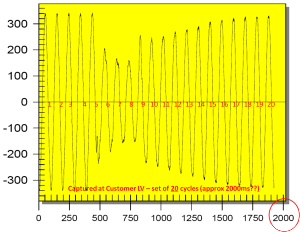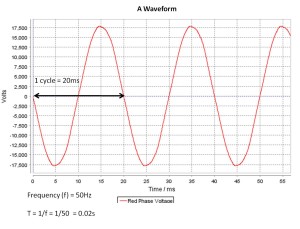Learnt a great deal from Amir Boshi of Satec and Powerqualitydoctor.com earlier today.
Thanks to Adrian Teo of Efunity for the kind invitation.

I had the privilege in toying around with the new HDPQ Xplorer earlier today, thanks to Terry Chandler of Power Quality Thailand. Definitely re-affirmed my belief that Dranetz PQ instruments and Dranview (especially) are at least one notch higher against its competitors.
p/s: Thanks Terry for visiting us today.
As a fan of powerXplorer Px-5 and Dranview, I got a little excited when Dranetz made this announcement.
Hope to get my hands on these ‘toys’ soon. 🙂
Go to dranetz.com for more info or visit their video link here.
p/s: If you have not used Dranview before, you don’t know what you have been missing.
In Singapore, a voltage dip is defined as per EN50160; “a sudden reduction of the supply voltage to a value between 90% and 1% of the declared voltage, followed by a voltage recovery after a short period of time; between 10ms and up to a minute”. Typically it lasts less than 200ms. Two things matter in the definition of a dip. See Figure 1.
1) Magnitude: This typically reflects the fault severity and also the proximity of the monitoring point to the fault location.
2) Duration: The timer starts when the voltage falls below the 90% threshold and ends when all voltages are equal to or above the 90% threshold. This is very much dependent on the time taken to isolate the fault and the nature of loads connected.
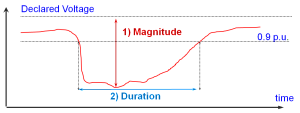
The Utility company here has a power quality monitoring system in place; from voltages 22kV and up to 400kV. As these are 3 phase 3 wire systems; line to line voltages are used in the definition of a dip. When there is such a dip, the worst dip by magnitude and its duration will be published by the Utility.
There is a significance of such definition being used in the 66kV and 22kV networks, whereby it is a resistively earthed grounded system (thru the neutral ground resistor). Here, a single phase fault will not be a registered as a voltage dip as the other two non-faulted phases will swell; ‘compensating’ the faulted phase. This will result in a drop of voltage (line to line) of usually less than 10% (hence not a dip). The Utility company here described such events as ‘Voltage variation’.
In recent times, voltage dips seem to be quite frequent in our office at 16 Boon Lay Way, Tradehub21. Tradehub21 is one of the many commercial buildings located in this Jurong East region; near to the International Business Park and also shopping malls like IMM, JCube, JEM and Westgate.
In the last 5 months, our office has recorded a total of 3 voltage dips; two originated from the Utility’s 230kV transmission fault and one which occurred last Friday due to a 22kV Customer’s Installation fault (along Jurong Gateway Road). It is fortunate in a way that this area is not a Semiconductor Hub, as just one dip will have costly implications on a semiconductor plant, let alone three.
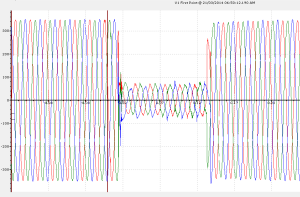
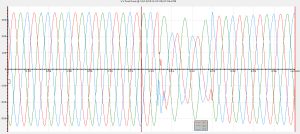
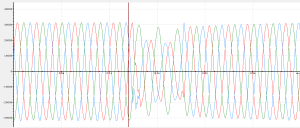
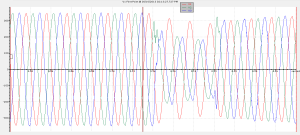
However, this is not to say that commercial buildings and shopping malls are immune to the effects of voltage dips. Here are the common known effects of voltage dips in a commercial building / shopping mall setting.
1) Chiller System
It is a known fact that chillers plants and its related equipment are sensitive to voltage dips. Relays, control contactors and the electronic/computerized controls may drop off during dips, hence causing the trip. The impact to building occupiers is small; as these effects are likely to be transparent to them; or at most minor discomfort due to a slightly raised ambient temperature.
Possible Mitigation
The sensitivity is sometimes made intentionally (and at times over-conservative) as there is a concern on possibilities of damage to the motor due to the high transient current upon normalization of system voltage (hence it is better to trip). A consultation with the Chillers’ OEM is almost necessary if one decides to protect its control circuits. This is to ensure that it will not result in damaging the motor.
Chiller controls can be secured with on-line UPS or voltage dip mitigation solutions like MiniDySC from SoftSwitching Technologies. Sensitive relays can be identified and replaced. Another option is to enable the Chiller for ‘Auto-Restart’ function if allowable.
Having an internal thorough proper restarting procedure of chillers in the event of tripping due to voltage dips in the network is also a form of ‘mitigation’ as it reduces the downtime of the Chillers. This usually needs close co-operation with the Utility company or install a permanent power quality monitoring system in the building to determine where the origin of the voltage dip (internal fault or fault from the Grid).
2) Lighting Circuits
During a voltage dip, flickering of the lights can be observed. In general, problems only arise when High Intensity Discharge (HID) lamps are used. These types of lightings are known to be sensitive to voltage dips and temporarily extinguish after a voltage dip. Re-ignition time usually takes up to 10 minutes.
Possible Mitigation
For HID lamps applications, one possible mitigation is to re-fit with “hot re-strike” igniter for instant lighting restoration. In the use of HID lamps in “critical areas”, it is best to deploy them alongside normal type of lightings (for eg. Fluorescent lightings), so as to avoid a ‘total blackout’.
In addition, occurrence of voltage dip across three phases is rare; hence the even distribution of lightings across the 3 phases can avoid a ‘total blackout’ during a voltage dip.
3) Escalators
During a voltage dip, the control contactors and PLC of the escalator may drop off. Another cause could be the activation of the phase monitoring relay, which is meant to activate upon loss of mains.
Governed by the Singapore Standard CP15:2004, escalators are designed to be brought to rest in a largely uniform deceleration in the event of loss of mains (thus not a safety concern). However public image may be affected.
Possible Mitigation
The control contactors and PLC can be secured through adding an uninterruptible power supply (UPS) and the phase monitoring relay can be upgraded to a relay equipped with a time delay for up to 0.2 sec. See Figure 6. This is based on CLP Power Hong Kong’s experience in voltage dip mitigation for escalators. It is also documented in Hong Kong’s” Code of Practice on the Design and Construction of Lift & Escalator.”
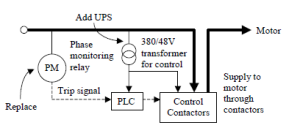
My personal accounts in conducting voltage dip tests on some of these escalators showed that in general, a voltage dip of more than 40%, regardless of duration that affects the supply to the control circuits will result in the escalator to stop. Mitigation equipment such as the MiniDySC was found to be an effective solution against such events.
A full implementation of such mitigation however will need further tests with the OEM escalator’s specialists to ensure that safety features related to its braking will not be compromised. Additionally, it may also require slight deviations from the existing CP15 as similarly re-defined in Hong Kong’s Code of Practice for Lifts & Escalators.
4) General Circuits
General circuits served by miniature circuit breakers (MCB) have also been reported to have tripped after a voltage dip. Immediately after a voltage dip, some MCBs may tripped due to large in-rush current drawn by motors, switch mode power supply, circuits containing control transformer, etc.
Possible Mitigation
Normally, if the MCBs are properly sized to cater for such ‘inrush’, the circuits should not trip.
SEMI F47
When it comes to voltage dip mitigation, the word “SEMI F47” will most likely to crop up. Without going into details, it is basically a minimum ride-through specification for semiconductor tools and processes as the semiconductor industry are most prone to voltage dips due to the nature of its operations. See Figure7.
However it must be noted that even such specification does not translate to 100% availability during a voltage dip as dips that are required for compliance with this specification occur between one phase and neutral, or between one pair of phase, at a time only. Hence for these 3 voltage dip incidents mentioned, a SEMI F47-rated equipment will also not guarantee you 100% availability.

To put in simply, in the SEMI F47 specification, an economical balance has been chosen such that semiconductor processing equipment which meets the requirements will be immune to most, but not all, real-world voltage dips at semiconductor plants.
Similarly if one is to consider mitigation equipment, a cost-benefit analysis has to be conducted as such mitigation do not come cheap. A historical dip statistics of the area from the Utility Company should always be among the first things to be obtained.

Faults (and hence voltage dips) are inherent in all power systems in the world. The frequencies of such occurrences can be minimized but not eliminated. Minimization requires the cooperation of all Stakeholders; the Regulator, the Utility company, the Licensed Electrical Engineers and Customers alike through regulations, regular preventive maintenance and condition monitoring.
And if need be, voltage dip mitigation equipment can be employed for those with sensitive operations or processes, albeit it will come at a price. But the price of leaving it to chance may even be greater (see Figure 8). Ultimately the user has to decide.
Power quality monitoring serves two main purposes:-
1) Benchmarking purposes: tracking loading and PQ indices (eg, harmonics, unbalance, flicker) over time, comparing against utility guidelines or known standards from the United Kingdom Engineering Recommendations, IEC and IEEE.
In Singapore, limits introduced in the Energy Market Authority’s Transmission Code took many references from the UK especially. An example is the voltage flicker / fluctuation limits; they are referenced to UK E.R P28: Planning Limits for Voltage Fluctuation Caused By Industrial, Commercial and Domestic Equipment in the United Kingdom. Another example is the Voltage harmonics limits which were referenced to the UK E/R G5/4: Planning levels for harmonic voltage distortion and the connection of non-linear equipment to the transmission networks and distribution networks of the United Kingdom.
In the market, there are two types of PQ monitoring available: permanent or portable. Traditionally, permanent PQ monitoring was exclusive to the utility companies. However over time, as PQ monitoring devices became more affordable and due to increased awareness regarding power quality, many buildings and manufacturing plants started to have PQ monitoring in place, sometimes integrated together with their internal Building Management System (BMS).
One known use of such system here in Singapore is to assist the facility managers whether can they restart / normalize their equipment (eg chillers) after they tripped following a voltage dip in the network. By having both current and voltage waveforms captured during a dip, it becomes a handy tool to inform the manager whether the fault (and hence the dip) originated upstream or an internal plant fault. Knowing that the fault originated upstream in the network will enable the manager to skip some checklists, hence faster restoration time (and less downtime).
2) Investigation purposes: whereby it has been determined that a power quality meter / instrumentation is necessary to aid in solving a particular power quality problem. In this particular case, a portable power quality meter is almost used. Note: there are instances too whereby a permanent type of PQ meter was made portable by installing it in some portable hard-case housing.
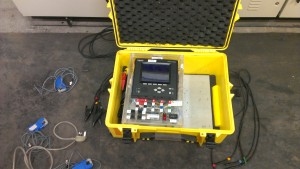
I have used several portable power quality meters, the first one being the HIOKI 3196 during my university internship days. I then went on to use other PQ meters like the Fluke 435 Series I, Fluke 434, Fluke 1750, Fluke 345, Hioki PW3198, Dranetz-BMI PX-5 Power Xplorer and Elspec G4500 Blackbox. These are the meters that I have used on an almost daily basis and I will be describing their strengths / weaknesses here based purely on my own experiences. (Note: I am not tied to any PQ meters manufacturer)
1) Fluke 435 Series 1
The Fluke 435 is an IEC 61000-4-30 Class A PQ instrumentation. It has several recording modes like Harmonics, Flicker, Dips/Swells, Inrush and a “Logger” mode.
Hardware: There were little differences between the Fluke 434 n 435. The F435 however have the “Power Logger” mode, hence trending of various parameters was a useful function. The major drawback is that when in “Power Logger” mode, the meter would not be able to capture any waveforms. In the event of a voltage dip for instance, a text one-liner will indicate that a dip has detected during the measurement, but no waveforms whatsoever. Another drawback is the maximum recording of 100 parameters only. This is a major drawback for me personally, as that will mean cutting down on the trending of the no. of individual harmonic orders. There is also no high speed transient capture capability.
Software: Powerlog has improved over the years, with the latest version (4.02) having a “clean and nice look” to it. It is adequate for most power quality trending analysis. It has also a useful data distribution histogram for statistical analysis. However my personal preference is to display harmonic current in terms of RMS amperes or in Total Demand Distortion (TDD). To do that, I will have to export out the fundamental current and various individual harmonic current % and re-do the calculation manually in excel. In certain applications, one may need to record the various parameters in 10-min trending (for eg) but requires 30-min values for maximum demand purposes. There is no feature to do that here, other than setting the F435 to record in 30-min intervals in the first place.
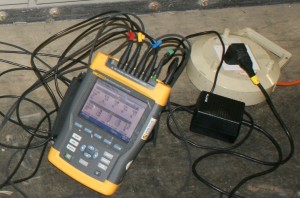
2) Fluke 434
Hardware: I had used the F434 version without the logging memory function. Hence there is no capability for it to log down trending values (eg aggregated 10-min trending). Hence this was its major handicap.
Software: Having used other software, Flukeview isn’t really good for me, but that’s just my personal opinion.
3) Fluke 345
The Fluke 345 is a single-phase AC/DC power quality clamp that I personally used to measure DC amperes in the presence of AC in Grid-Tied PV applications, to check for the presence of DC injection back to Grid.
Hardware:
Truth to be told, there isn’t any instrumentation available in measuring small amount of DC in the presence of large AC. This is a great tool nevertheless for spot-measurements and verification of loadings when installing a portable power quality meter.
Software:
via PowerLog. Same comments as above.
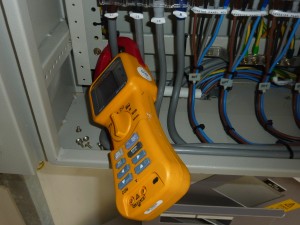
4) Hioki PW3198.
This is the latest PQ meter that recently arrived in my hands. It is a Class A PQ meter, able to record trending and capture waveforms too if certain thresholds set are breached.
Hardware:
In my opinion, this is a much better PQ meter than the Fluke 435 Series 1. There is no limitation on no. of parameters to be recorded and it can record trendings and waveforms together (that is how a PQ meter should function, in my opinion). It is also able to capture high speed transient. Two disadvantages that I come across are as follows: 1) Two voltage inputs (+ and -) for every phase, hence the physical connection for a three phase wye will be different from a three phase delta. I have witnessed minor accidents where users were not familiar in a three phase delta setup, causing short-circuits in the PQ meter. 2) For connection of custom Non-Hioki clamps to it, it can only accept clamps with certain mv/A ratio only (hence not fully 100% customizable)
Software:
Similar to the PowerLog, it is adequate for most power quality analysis. Also to add, it is able to trend out harmonic current values of the individual orders in terms of RMSamperes, which is good. It cannot however total up these values and give the user the total harmonic current (in RMS amperes). I have to export them out and calculate them manually via Excel. Another plus is that it is able to give 30min interval values for maximum demand, as compared to PowerLog via the F435.

5) Dranetz-BMI PX-5 Power Xplorer
This is a Class A PQ meter from Dranetz-BMI with hi-speed transient capturing capability. It is able to record trending and capture waveforms at the same time.
Hardware: It has similar capability as the Hioki PW3198. Even its voltage input configurations are similar, meaning the physical configuration at the voltage inputs will be different between a 3 phase wye and a 3phase delta connection. IEC 61000-4-30 gives guidelines on how the average aggregation of the trending values must be:
If you are familiar with PQ meters, there is also a maximum / minimum trending plot. On how this is implemented very much depends on the manufacturer, as it is not specified in the Standard. Dranetz-BMI used a single-cycle maximum/minimum value, meaning the maximum/minimum RMS value you will see is from a single cycle, not from a set of 10cycles. This helps greatly when one is doing troubleshooting purposes, and the waveform capturing mode didn’t activate as it was still within the ‘thresholds’.
There are also downsides for the PX-5. The flexible clamps that came with the meter were the LEM Flex RR3035A. Its connection to the PX-5 is via a ‘coaxial cable’ connection. Over time due to wear and tear, the ‘coaxial cable’ became loose easily and resulted in many unusually high current spikes recorded. Another problem I encountered was the overload of the circuit signals due to the wrong setting of the clamps’ measuring range (it has a range of 30/300/3000A). There was one occasion when I had set a low 300A measuring range and left it over night. Due to increase of loads in night time (loads went up to above 1000A, the clamps became saturated and caused many high frequency voltage transients to be recorded. I admit that it was my mistake, but I would have though that voltage and current were separate issues altogether!
Software: Dranview is by far the best power quality analyzing software ever. Nothing comes close to it in my opinion. The option of changing harmonic current to THD%, TDD% and its absolute values in terms of its RMS can be simply be done with a few clicks. Statistical analysis can be done with just adding on some tables to the trending graphs. I could go on and on over here !
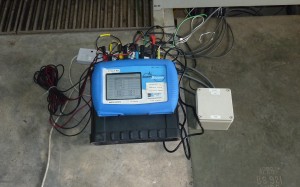
6) Fluke 1750 Power Recorder
The F1750 prides itself as a PQ meter that “records everything” thru its “adaptive” threshold. It was previously an RPM PQ meter, acquired by Fluke. It has also a high speed transient capture capability.
Hardware: Though it has the benefits of “recording everything”, every cycle of it without setting up any thresholds it is not a Class-A compliant meter. You will not see in any of the specs saying it is Class A compliant but you may read that it measures according to Class-A algorithms. This is because its voltage accuracy is +/-0.2% instead of as required +/- 0.1%. And it does not have the ability to be time-synched to a GPS (though this is largely a non-issue to me personally as the practicality of connecting a GPS module to a PQ meter inside a switchroom is almost zero). Despite its shortcomings, the F1750 is useful in troubleshooting purposes and finding faults in a system for a short period of measurement. When a PQ meter captures everything, it will be up to the PQ investigator to be the smart one to decipher what is important or not.
Software: The current version is Power Analyze 2.4. It is still very much a basic analyzing software. I have used it since its early days whereby things like unbalance and flicker were not available options in the software. Things were then added on as time goes by. And if you notice properly, voltage/current unbalance can be found under the ‘THD’ tab. I cannot understand why though. I suspect that it ran out of tabs to display!
It can however gives me the individual order harmonic current in RMSamperes. Similar to the Hioki PW3198, I have to manually export the individual harmonic current (in amperes) out to calculate the total harmonic current in RMSamperes. However the ridiculous thing that I found is that the software only allowed me to export one individual order at each time only. That means I have to export out 49 times for harmonic orders 2nd to 50th!
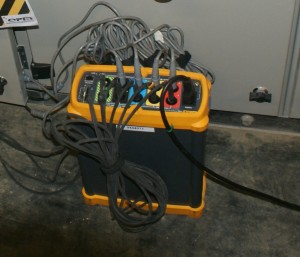
7) Elspec G4500 Blackbox
This is a port-over product from its permanent monitoring series. It is another PQ meter that prides itself in measuring every waveform (1024 samples per cycle for voltage) from start to end (I used the model which has 8GB memory). It is also a Class A compliant meter. It however lacks a high speed transient capture capability.
Hardware: It has an in-built router enabling wireless access to it. Physical inputs to the PQ meter are similar to F1750 / F435. Configurations whether it is measuring a three phase wye or three phase delta is configured via software. It has also an optional temperature probe. And it has these nice blue LED lights above every current and voltage input; to indicate if it is connected and measuring. Setting up is via web interface and is quite straightforward.
Software: An SQL database is firstly needed to be installed on the downloading / viewing PC. It has a basic software, adequate for most power quality analysis. It is able to trend out values in terms of both the IEC 61000-4-30 Class A guidelines or even in cyclic RMS (which will be more accurate). It can also trend out individual and total harmonic current in RMSamperes. Its biggest drawback and main handicap is its downloading and “unzip portion”, whereby it can easily takes half an hour to display the trending / waveform recorded over one week of measurement. In this sense, it is not very practical in my opinion, as many times, a PQ investigator or the Customer will want to view the data recorded almost immediately. A half an hour is simply too long. (used a Lenovo Thinkpad X220 I5-2520 4GB). My opinion is that it was originally designed for a permanent installation, whereby data is being brought back to the PC/server to download and process at fixed short intervals and not in the portable setup scenario whereby one week of data is downloaded and processed at once. It is a neat meter, if only the the downloading/viewing issue can be resolved.
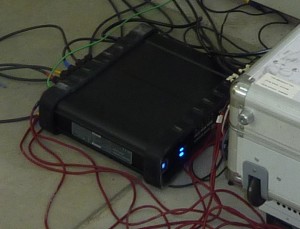
In my opinion, if I am to purchase new PQ meters it will still be
5) Dranetz-BMI PX5 for its per cycle min/max and also its powerful software.
Ever since introduced to the area of power quality and its definitions by my first manager, Azmi Rahmat, it has become a pet-peeve for me everytime someone used the words “trending” and “waveform” interchangeably.
To put the record straight, it is not the SAME.
And it has become my personal way in differentiating a PQ engineer from a non-PQ engineer 🙂
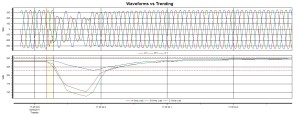
In relating to this, I had a previous experience whereby the Customer demanded to know why their voltage dip duration is far off from utility’s official voltage dip results at 22kV. Their monitoring was at low voltage side (230V Phase voltage / 400V Line voltage).
While it is known fact that nearer to the loads, the dip recovery may be slightly slower. However this was incredibly long (I was firstly given the trending only).
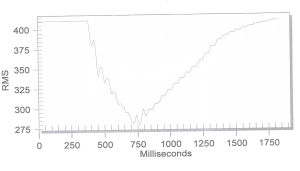
Only after I compared with their recorded waveforms, then I realised (and chuckled too); their monitoring system had a wrong time scale!
